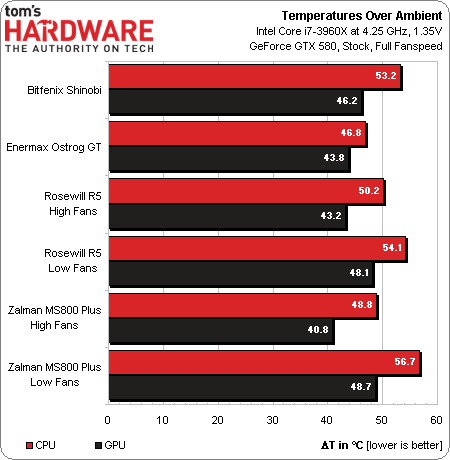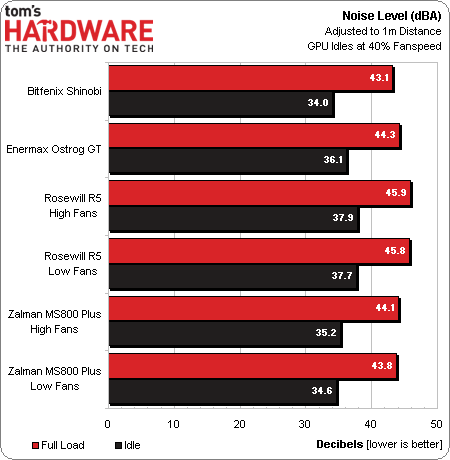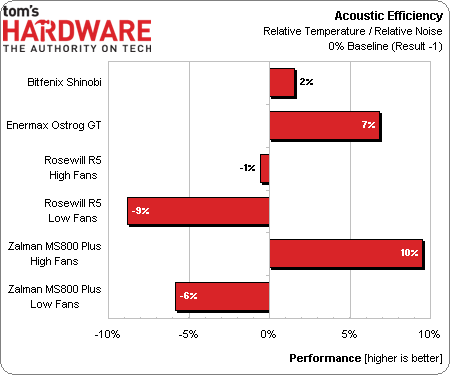Four More Sub-$100 Cases For Your Gaming Build, Reviewed
Our second group of value-oriented cases looked good in the photo preview, but we really wanted to see how they’d perform with a load of hot gaming hardware. Will these beat their predecessors in terms of quality, feature, hardware support, or value?
Temperature, Noise, and Acoustic Efficiency
Why you can trust Tom's Hardware
The Enermax Ostrog GT gives us the lowest CPU temperatures in today’s test, but Zalman’s MS800 Plus keeps our graphics card coolest. Rosewill’s R5 takes second place in both measurements.
Even if Rosewill’s case fans produced twice the volume at full speed as they do at minimum speed, our graphics card and CPU fans would drown them out. That’s partly because Rosewill positions its side panel vents right next to our CPU and graphics fans, blocking little to none of their noise.
BitFenix wins the noise reduction race, leaving Zalman’s more-expensive MS800 Plus in position two. That sets us up for an interesting heat-to-noise comparison. And for that, we need a little extra calculation.
First we need a baseline. Nothing is silent and noise has no limits. So, we averaged the noise of all tests to create a group average. In our comparison chart, the average of today’s contenders is called a baseline, and the word "relative" refers to how much better or worse each case is than that baseline. Now that we have baselines, we can put noise and heat on a percent scale.
Dividing baseline temperature by a case’s average temperature gives it a higher percentage score for a lower thermal reading. Dividing a case’s average noise level by baseline noise level gives it a higher percentage score for a higher reading. Since a higher divisor produces a lower dividend, the case with either the lowest temperature or lowest noise level can lead this heat/noise calculation, and a case that has both lower temperatures and lower noise will surely win.
Since nothing can be more than 100% efficient, I offset the scale to zero by subtracting 100%. With its fans at full speed, Zalman’s MS800 Plus beats the group average by 10%. Enermax’s Ostrog GT takes second place with 7% above-average overall performance.
Current page: Temperature, Noise, and Acoustic Efficiency
Prev Page Test Settings Next Page Which Of These Four Cases Takes Top Spot?Get Tom's Hardware's best news and in-depth reviews, straight to your inbox.
-
jdwii Why no love for coolermaster its easily the best Case company out there, i rarely even consider anything else. For just 60$ they offer one heck of a deal.Reply -
Crashman jdwiiWhy no love for coolermaster its easily the best Case company out there, i rarely even consider anything else. For just 60$ they offer one heck of a deal.Tom's HardwareOf the 28 companies we invited to participate, 11 responded with cases they thought would give the Tom's Hardware audience the best balance between quality, features, and price. We divided the round-up into three groups based on when each of the samples arrived.Reply -
griptwister Wow! Looking for a new case! It's time to upgrade my Antec OneHundred windowed. it's too loud with all the fans. and the PSU. Looks like I'll be going with a Zalman MS800 for my next rig! I liked the look of the z11 better at first, but seeing what the MS 800 looks like with a few LEDs, it seems classy and sleek yet not overdone. Great review THW!Reply -
slomo4sho Thank you for not doing a slide show for this like the other reviews.Reply
Also, still looking forward to a review of the Cooler Master HAF XB. -
dalmvern slomo4shoThank you for not doing a slide show for this like the other reviews. Also, still looking forward to a review of the Cooler Master HAF XB.Reply
Apparently you were unaware of the slideshow they released last week. What Toms has done with all of these round ups was take the pictures and post them, then once they get done with their battery of tests they post the results and commentary afterward. -
nd22 Excellent review! I like to get the best possible performance for the money I spent and it seems that these cases you reviewed are perfect for a mid-end gaming build I am planning to do! How about some exotic cases to review for us Tom? For example I would like to see a review of cooler master haf xb or fractal 304.Reply -
sincreator It's about time Zalman sent you guys one of their budget oriented cases. I bought the Zalman Z9+ for $34.99 last year with free shipping from NCIX, and I absolutely love the case. Great quality with a huge amount of features for a case of that price. It has more features than my brothers Antec 900 surprisingly, and it probably should of been $70-80. I'm not complaining though. lol. I have recommended the MS 800 and the Zalman Z9+ to a few friends, depending on their budget. They all loved the cases and were shocked at what they got for the money. I'd love to see more reviews for Zalman's cases on Tom's.Reply -
ubercake Ok. Where are the Tom's models?Reply
Inner butt cheek. Side boob. That's what's going to sell cases. :) -
Crashman ubercakeOk. Where are the Tom's models?Inner butt cheek. Side boob. That's what's going to sell cases.Sorry, all the models near this location are BBW. I don't believe that would go-over with the majority :pReply



